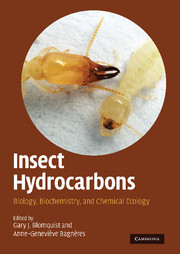Book contents
- Frontmatter
- Contents
- List of contributors
- Foreword
- Acknowledgments
- Part I Chemistry, Biochemistry, and Physiology
- 1 Introduction: history and overview of insect hydrocarbons
- 2 Structure and analysis of insect hydrocarbons
- 3 Biosynthesis of cuticular hydrocarbons
- 4 Molecular biology and genetics of hydrocarbon production
- 5 Site of synthesis, mechanism of transport and selective deposition of hydrocarbons
- 6 Cuticular lipids and water balance
- 7 Chemical taxonomy with hydrocarbons
- 8 Chemical synthesis of insect cuticular hydrocarbons
- 9 Oxygenated derivatives of hydrocarbons
- Part II Chemical Communication
- Index
1 - Introduction: history and overview of insect hydrocarbons
from Part I - Chemistry, Biochemistry, and Physiology
Published online by Cambridge University Press: 18 May 2010
- Frontmatter
- Contents
- List of contributors
- Foreword
- Acknowledgments
- Part I Chemistry, Biochemistry, and Physiology
- 1 Introduction: history and overview of insect hydrocarbons
- 2 Structure and analysis of insect hydrocarbons
- 3 Biosynthesis of cuticular hydrocarbons
- 4 Molecular biology and genetics of hydrocarbon production
- 5 Site of synthesis, mechanism of transport and selective deposition of hydrocarbons
- 6 Cuticular lipids and water balance
- 7 Chemical taxonomy with hydrocarbons
- 8 Chemical synthesis of insect cuticular hydrocarbons
- 9 Oxygenated derivatives of hydrocarbons
- Part II Chemical Communication
- Index
Summary
The long-chain hydrocarbons of insects play central roles in the waterproofing of the insect cuticle and function extensively in chemical communication where relatively non-volatile chemicals are required. The recognition of the critical roles that hydrocarbons serve as sex pheromones, kairomones, species and gender recognition cues, nestmate recognition, dominance and fertility cues, chemical mimicry, primer pheromones and task-specific cues has resulted in an explosion of new information in the past several decades, and, indeed, served as the impetus for this book.
A number of reviews and chapters on specific topics related to insect hydrocarbons have been published over the past few decades (Jackson and Blomquist, 1976a; Blomquist and Jackson, 1979; Howard and Blomquist, 1982, 2005; Blomquist and Dillwith, 1985; Blomquist et al., 1987; Lockey, 1988, 1991; Howard, 1993; Nelson and Blomquist, 1995; Gibbs, 2002), and in this book we attempt to bring this information up-to-date and in one place. At the time the first insect hydrocarbons were chemically identified in the 1960s and early 1970s, no one could have predicted the amount of interest that they would generate. Indeed, a pioneer in this field advised one of the authors (GJB) to go into a field other than insect hydrocarbons as he began his independent research career in the early 1970s, as he saw no future in this area. This prophecy proved very wrong and illustrates how difficult it is to predict the future of any scientific field.
- Type
- Chapter
- Information
- Insect HydrocarbonsBiology, Biochemistry, and Chemical Ecology, pp. 3 - 18Publisher: Cambridge University PressPrint publication year: 2010
- 59
- Cited by

